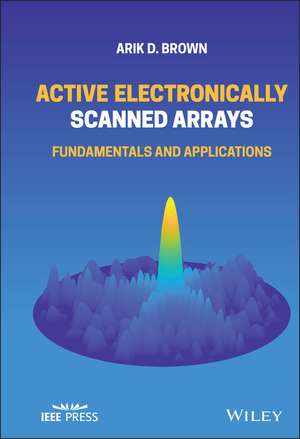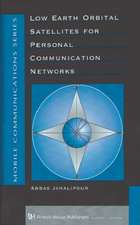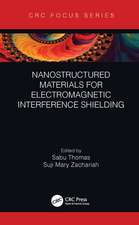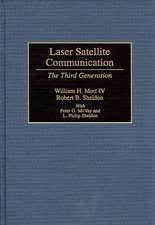Active Electronically Scanned Arrays – Fundamentals and Applications: IEEE Press
Autor AK Brownen Limba Engleză Hardback – 9 dec 2021
In Active Electronically Scanned Arrays: Fundamentals and Applications, electromagnetics expert Dr. Arik D. Brown delivers a foundational treatment of active electronically scanned arrays (AESAs) ideal for engineering students and professionals. The distinguished author provides an overview of the primary subsystems of an AESA and detailed explanations of key design concepts and fundamentals for subsystems, including antenna array elements, transmit/receive modules, and beamformers.
Performance results for various AESA architectures often found in industry, including analog, subarrayed, and digital beamforming AESAs, are discussed. With a focus on practical knowledge and applications, Active Electronically Scanned Arrays: Fundamentals and Applications offers an accessible overview of a technology critical to the implementation of collision avoidance in cars, air surveillance radar, communication antennas, and defense technologies.
The book also includes:
- A thorough introduction to AESAs, including a top-level block diagram view and explanations of key components and subsystems
- Detailed explanations of the impact of AESAs on mission applications including Radar, Electronic Attack (EA), Electronic Support Measures (ESM), SIGINT and Communications
- Comprehensive explorations of antenna array elements, transmit/receive modules, and beamformers including their purpose, functions, and practical design considerations
- In-depth examinations of AESA architecture performance for current and future systems
- Utility of AESAs for implementing adaptive beamforming for Electronic Counter-Countermeasures (ECCM)
Perfect for electrical engineers working with active electronically scanned arrays, electronic warfare technologies, radar, or communications, Active Electronically Scanned Arrays: Fundamentals and Applications will also prove to be an invaluable resource for defense students undertaking military education and training.
Din seria IEEE Press
- 5%
 Preț: 599.39 lei
Preț: 599.39 lei - 20%
 Preț: 684.17 lei
Preț: 684.17 lei - 24%
 Preț: 667.15 lei
Preț: 667.15 lei - 24%
 Preț: 1226.95 lei
Preț: 1226.95 lei - 24%
 Preț: 707.88 lei
Preț: 707.88 lei - 24%
 Preț: 702.63 lei
Preț: 702.63 lei - 24%
 Preț: 617.46 lei
Preț: 617.46 lei - 24%
 Preț: 600.44 lei
Preț: 600.44 lei - 24%
 Preț: 741.54 lei
Preț: 741.54 lei - 24%
 Preț: 706.13 lei
Preț: 706.13 lei - 24%
 Preț: 704.88 lei
Preț: 704.88 lei - 24%
 Preț: 695.87 lei
Preț: 695.87 lei - 24%
 Preț: 618.99 lei
Preț: 618.99 lei - 24%
 Preț: 546.25 lei
Preț: 546.25 lei - 14%
 Preț: 858.78 lei
Preț: 858.78 lei - 20%
 Preț: 446.58 lei
Preț: 446.58 lei - 24%
 Preț: 672.04 lei
Preț: 672.04 lei - 24%
 Preț: 612.66 lei
Preț: 612.66 lei - 24%
 Preț: 572.10 lei
Preț: 572.10 lei - 14%
 Preț: 743.46 lei
Preț: 743.46 lei - 23%
 Preț: 1031.28 lei
Preț: 1031.28 lei -
 Preț: 415.98 lei
Preț: 415.98 lei - 9%
 Preț: 1010.21 lei
Preț: 1010.21 lei - 9%
 Preț: 1499.89 lei
Preț: 1499.89 lei - 9%
 Preț: 806.07 lei
Preț: 806.07 lei - 9%
 Preț: 1069.47 lei
Preț: 1069.47 lei - 9%
 Preț: 1117.45 lei
Preț: 1117.45 lei - 20%
 Preț: 723.20 lei
Preț: 723.20 lei - 9%
 Preț: 923.82 lei
Preț: 923.82 lei - 9%
 Preț: 994.01 lei
Preț: 994.01 lei - 9%
 Preț: 963.51 lei
Preț: 963.51 lei - 9%
 Preț: 1969.97 lei
Preț: 1969.97 lei - 9%
 Preț: 1021.22 lei
Preț: 1021.22 lei - 9%
 Preț: 742.90 lei
Preț: 742.90 lei - 9%
 Preț: 1485.82 lei
Preț: 1485.82 lei - 9%
 Preț: 1020.25 lei
Preț: 1020.25 lei - 9%
 Preț: 930.31 lei
Preț: 930.31 lei - 9%
 Preț: 997.70 lei
Preț: 997.70 lei - 9%
 Preț: 970.56 lei
Preț: 970.56 lei - 9%
 Preț: 781.15 lei
Preț: 781.15 lei - 9%
 Preț: 1162.23 lei
Preț: 1162.23 lei - 9%
 Preț: 1030.34 lei
Preț: 1030.34 lei - 9%
 Preț: 815.85 lei
Preț: 815.85 lei - 9%
 Preț: 1130.31 lei
Preț: 1130.31 lei - 9%
 Preț: 1560.74 lei
Preț: 1560.74 lei - 9%
 Preț: 1289.30 lei
Preț: 1289.30 lei - 9%
 Preț: 1036.75 lei
Preț: 1036.75 lei - 9%
 Preț: 968.96 lei
Preț: 968.96 lei - 9%
 Preț: 1130.63 lei
Preț: 1130.63 lei - 9%
 Preț: 1010.82 lei
Preț: 1010.82 lei
Preț: 895.04 lei
Preț vechi: 983.56 lei
-9% Nou
171.26€ • 178.83$ • 141.42£
Carte tipărită la comandă
Livrare economică 15-29 aprilie
Specificații
ISBN-10: 1119749050
Pagini: 272
Dimensiuni: 152 x 229 x 16 mm
Greutate: 0.53 kg
Editura: Wiley
Seria IEEE Press
Locul publicării:Hoboken, United States
Cuprins
Preface xiii Acknowledgments xv Acronyms xvii 1 AESA Overview 1 1.1 Introduction 1 1.2 AESA History 1 1.3 AESA Applications 3 1.3.1 RADAR 3 1.3.2 ElectronicWarfare 7 1.3.2.1 Electronic Attack 9 1.3.2.2 Electronic Support Measures 9 1.3.3 Communications 10 1.3.4 Signals Intelligence 10 1.4 AESA Point of Reference 11 1.5 Block Diagram 15 1.5.1 Antenna Array Elements 15 1.5.2 Transmit Receive Modules 16 1.5.3 Beamformer 16 1.6 AESA Cascaded Performance and Architecture Selection 16 References 17 2 AESA Theory 19 2.1 Introduction 19 2.2 General One-Dimensional Formulation 20 2.2.1 Pattern Expression without Electronic Scanning 20 2.2.2 Pattern Expression with Electronic Scanning 22 2.3 AESA Fundamental Topics 23 2.3.1 Beamwidth 23 2.3.2 Instantaneous Bandwidth 24 2.3.3 Grating Lobes 27 2.3.4 Error Effects 29 2.3.5 Quantization Effects 29 2.3.6 Random Error Effects (Amplitude and Phase) 30 2.4 One-Dimensional Pattern Synthesis 31 2.4.1 Varying Amplitude Distribution 33 2.4.2 Varying Frequency 39 2.4.3 Varying Scan Angle 39 2.5 Conformal Arrays 40 2.5.1 Array Pattern for a Linear Array 40 2.5.2 Array Pattern for a Conformal Array 42 2.5.3 Example 43 2.5.3.1 Conformal One-Dimensional Array 43 2.6 2D AESA Pattern Formulation 44 2.6.1 AESA Spatial Coordinate Definitions 45 2.6.2 Antenna Coordinates 46 2.6.3 Radar Coordinates 48 2.6.4 Antenna Cone Angle Coordinates 49 2.6.5 Sine Space Representation 50 2.6.6 AESA Element Grid 52 2.6.6.1 Rectangular Grid 52 2.6.6.2 Triangular Grid 55 2.6.7 Two-Dimensional Pattern Synthesis 56 2.6.7.1 Ideal Patterns 57 2.7 Circular Grid AESA Patterns 61 2.8 Tilted AESA Patterns 66 2.9 Integrated Gain 71 References 73 3 Array Elements 75 3.1 Introduction 75 3.2 Bandwidth 78 3.3 Polarization 81 3.3.1 Electromagnetic Polarization Fundamentals 82 3.3.2 Types of Polarization 83 3.3.2.1 Linear Polarization 83 3.3.2.2 Circular Polarization 84 3.3.2.3 Elliptical Polarization 85 3.3.3 Polarization States 87 3.3.4 Array Polarization 88 3.3.4.1 Key Requirements 90 3.4 Array Grid 91 3.5 Mismatch and Ohmic Loss 92 3.6 Active Match 95 3.7 Scan Loss 98 References 101 4 Transmit Receive Modules 103 4.1 Overview 103 4.1.1 TRM Baseline Topology 108 4.1.1.1 TR Switches 108 4.1.1.2 Amplifiers 109 4.1.1.3 Pre-Amplifier and HPA 109 4.1.1.4 LNA 110 4.1.1.5 Phase Shifter 110 4.1.1.6 Attenuator 110 4.1.1.7 Circulator 110 4.1.1.8 Receiver Protector 111 4.1.1.9 Filters 111 4.1.2 TRM Topology Types 111 4.1.2.1 Receive Only 111 4.1.2.2 Channelization 112 4.1.2.3 Simultaneous Beams 113 4.1.2.4 Multi-Channel TRMs 113 4.2 Transmit Operation 115 4.2.1 Efficiency and Amplifier Classes 116 4.2.2 P1dB 117 4.2.3 Linearity 118 4.2.3.1 Harmonics and Intermodulation Products 118 4.2.3.2 Intercept Point 121 4.2.4 Wideband Operation 123 4.2.4.1 Nonlinear Beams 123 4.2.5 Thermal Implications Due to Output Match 125 4.3 Receive Operation 127 4.4 Reliability 128 4.4.1 Probability of Failed Elements 129 4.4.2 MTBF 132 References 134 5 Beamformers 135 5.1 Introduction 135 5.1.1 Tile and Brick Architectures 136 5.1.2 Corporate and Noncorporate Beamforming 140 5.2 Lossless Beamformer 142 5.2.1 Transmit 142 5.2.2 Receive 143 5.3 BeamformerWeighting 145 5.4 DistributedWeighting 148 5.5 Beam Spoiling 149 5.6 Monopulse for Angle Estimation 153 5.6.1 Three Channel Monopulse with an AESA 154 5.6.1.1 Calibration for Monopulse Coupler Errors 159 5.6.2 Two-Channel Monopulse with an AESA 159 5.6.2.1 Low Sidelobe Delta Beams 162 References 163 6 AESA Cascaded Performance 165 6.1 Introduction 165 6.2 Fundamental Expressions for Cascade Calculations 168 6.2.1 Noise Model 168 6.2.1.1 Active Device 168 6.2.1.2 Resistive Device 169 6.2.1.3 Noise Factor Definition 169 6.2.2 Cascaded Noise Factor 170 6.3 AESA Cascaded Performance 174 6.3.1 AESA Output Signal Power 174 6.3.2 AESA Output Noise Power 175 6.3.3 AESA Signal/Noise Gain and Noise Factor 177 6.3.4 AESA nth-Order Intercept Point 179 6.3.5 AESA Spurious Free Dynamic Range 181 References 182 7 AESA Architectures 183 7.1 Introduction 183 7.2 Baseline Architecture 183 7.3 Subarray Architectures 186 7.4 Subarray Pattern Formulation 188 7.5 Subarray Beamforming 189 7.5.1 Subarray Phase Shifter Beamforming 189 7.5.2 Subarray Time Delay Beamforming 191 7.5.3 Subarray Digital Beamforming 194 7.6 Overlapped Subarrays 195 7.7 Elemental DBF Architecture 199 7.8 Adaptive Beamforming 201 References 207 Appendix A Array Factor (AF) Derivation 209 Appendix B Instantaneous Bandwidth Derivation 211 Reference 212 Appendix C Triangular Grid Grating Lobes Derivation 213 References 215 Appendix D General Expression for Intercept Point Derivation 217 Appendix E Impact of Failed Elements on AESA Performance 219 Appendix F Sidelobe Blanking with an AESA 223 Reference 227 Appendix G External Noise Considerations 229 Appendix H Important AESA Equations Reference 233 H.1 System Level Equations 233 H.1.1 Radar Range Equation 233 H.1.2 Signal and Noise Gain 233 H.1.3 Array Gain 234 H.2 AESA Theory 234 H.2.1 1D Pattern 234 H.2.1.1 Phase Shifter and Time Delay Steering 234 H.2.1.2 General Expression 234 H.2.1.3 Conformal Array 234 H.2.1.4 Alternate AF Expression 235 H.2.2 2D Pattern 235 H.2.3 Beamwidth 235 H.2.4 Instantaneous Bandwidth (IBW) 235 H.2.5 Grating Lobes 235 H.2.6 AESA Errors 236 H.2.7 Coordinate System Transformations 236 H.2.8 Sine Space 237 H.2.9 Roll, Pitch, and Yaw Formulas 237 H.2.10 Integrated Gain 237 H.3 Array Elements 237 H.3.1 Fractional Bandwidth 237 H.3.2 Polarization 238 H.3.3 Active Match 238 H.3.4 Scan Loss 238 H.4 Transmit Receive Modules 239 H.4.1 Amplifier Expressions 239 H.4.2 Reliability 239 H.5 Beamformer 240 H.5.1 General Beamformer Expressions 240 H.5.2 Beam Spoiling 240 H.5.3 Monopulse AOA 240 H.6 AESA Cascaded Performance 241 H.6.1 Fundamental Expressions 241 H.6.2 AESA Cascaded Expressions 241 H.7 Adaptive Beamforming 242 Reference 243 Index 245
Descriere
In Active Electronically Scanned Arrays: Fundamentals and Applications, electromagnetics expert Dr. Arik D. Brown delivers a foundational treatment of active electronically scanned arrays (AESAs) ideal for engineering students and professionals. The distinguished author provides an overview of the primary subsystems of an AESA and detailed explanations of key design concepts and fundamentals for subsystems, including antenna array elements, transmit/receive modules, and beamformers.
Performance results for various AESA architectures often found in industry, including analog, subarrayed, and digital beamforming AESAs, are discussed. With a focus on practical knowledge and applications, Active Electronically Scanned Arrays: Fundamentals and Applications offers an accessible overview of a technology critical to the implementation of collision avoidance in cars, air surveillance radar, communication antennas, and defense technologies.
The book also includes:
- A thorough introduction to AESAs, including a top-level block diagram view and explanations of key components and subsystems
- Detailed explanations of the impact of AESAs on mission applications including Radar, Electronic Attack (EA), Electronic Support Measures (ESM), SIGINT and Communications
- Comprehensive explorations of antenna array elements, transmit/receive modules, and beamformers including their purpose, functions, and practical design considerations
- In-depth examinations of AESA architecture performance for current and future systems
- Utility of AESAs for implementing adaptive beamforming for Electronic Counter-Countermeasures (ECCM)
Perfect for electrical engineers working with active electronically scanned arrays, electronic warfare technologies, radar, or communications, Active Electronically Scanned Arrays: Fundamentals and Applications will also prove to be an invaluable resource for defense students undertaking military education and training.














